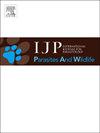深入了解感染突尼斯北非刺猬Atelerix alggirus的蜱虫和跳蚤物种
IF 2
3区 医学
Q3 ECOLOGY
International Journal for Parasitology-Parasites and Wildlife
Pub Date : 2025-06-30
DOI:10.1016/j.ijppaw.2025.101109
引用次数: 0
摘要
刺猬是一种小型野生哺乳动物,已知携带各种体外寄生虫,包括硬蜱和跳蚤,它们可以将媒介传播的病原体传播给人类和动物。我们调查了在突尼斯北部捕获的10只刺猬(Atelerix algirus)的体外寄生虫,发现蜱虫和跳蚤。基于形态特征和分子方法,通过16s rRNA、线粒体细胞色素C氧化酶亚基I和18s rRNA基因的部分扩增,鉴定了体外寄生虫的种类。共鉴定出4种蜱,分别为血蜱、血头蜱、烟性伊蚊和埃及透明眼蜱。分子分析证实了图兰血蜱亚种的存在,系统发育聚类表明与阿尔及利亚、土耳其和中国的蜱虫种群存在遗传关系。另外还鉴定出两种跳蚤:刺猬蚤始祖蚤(Archaeopsylla erinacei)和猫蚤栉头蚤(Ctenocephalides felis),这两种跳蚤都是病原体的媒介。我们证实了刺猬感染了erinacei maura古菌,获得的序列与先前在西班牙报道的序列聚类密切。这种遗传相似性可能表明这个亚种有一个共同的起源,并表明这个亚种有更广泛的地理分布。我们的研究强调了理解刺猬、体外寄生虫及其环境之间相互作用的重要性。我们的发现可能为公共卫生策略和野生动物管理提供信息,旨在控制外寄生虫种群并降低人畜共患疾病出现的风险。本文章由计算机程序翻译,如有差异,请以英文原文为准。

Insight into tick and flea species infesting the North African Hedgehog Atelerix algirus in Tunisia
Hedgehogs are small wild mammals known to host various ectoparasites, including hard ticks and fleas, which can transmit vector-borne pathogens to humans and animals. We investigated the ectoparasites infesting 10 hedgehogs (Atelerix algirus) captured in northern Tunisia and found both ticks and fleas. Ectoparasite species were identified based on their morphological characteristics as well as using molecular methods via the partial amplification of the 16 S rRNA, the mitochondrial Cytochrome C Oxidase subunit I, and the 18 S rRNA genes. Four tick species were identified: Haemaphysalis erinacei, followed by Rhipicephalus sanguineus, Ixodes ventalloi, and Hyalomma aegyptium. Molecular analysis confirmed the presence of the subspecies Haemaphysalis erinacei turanica, with phylogenetic clustering suggesting a genetic relationship with tick populations in Algeria, Turkey, and China. Two additional flea species were identified: Archaeopsylla erinacei, the hedgehog flea, and Ctenocephalides felis, the cat flea, both known to be vectors of pathogens. We confirmed that hedgehogs were infested with Archaeopsylla erinacei maura, with the obtained sequences clustering closely with those previously reported in Spain. This genetic similarity may suggest a shared origin and indicate a wider geographic distribution for this subspecies. Our study underscores the importance of understanding the interactions between hedgehogs, ectoparasites, and their environments. Our findings may inform public health strategies and wildlife management, aiming to control ectoparasite populations and reduce the risk of the emergence of zoonotic diseases.
求助全文
通过发布文献求助,成功后即可免费获取论文全文。
去求助
来源期刊

International Journal for Parasitology-Parasites and Wildlife
Medicine-Infectious Diseases
CiteScore
3.80
自引率
5.60%
发文量
113
审稿时长
45 days
期刊介绍:
The International Journal for Parasitology: Parasites and Wildlife (IJP-PAW) publishes the results of original research on parasites of all wildlife, invertebrate and vertebrate. This includes free-ranging, wild populations, as well as captive wildlife, semi-domesticated species (e.g. reindeer) and farmed populations of recently domesticated or wild-captured species (e.g. cultured fishes). Articles on all aspects of wildlife parasitology are welcomed including taxonomy, biodiversity and distribution, ecology and epidemiology, population biology and host-parasite relationships. The impact of parasites on the health and conservation of wildlife is seen as an important area covered by the journal especially the potential role of environmental factors, for example climate. Also important to the journal is ''one health'' and the nature of interactions between wildlife, people and domestic animals, including disease emergence and zoonoses.
 求助内容:
求助内容: 应助结果提醒方式:
应助结果提醒方式:


